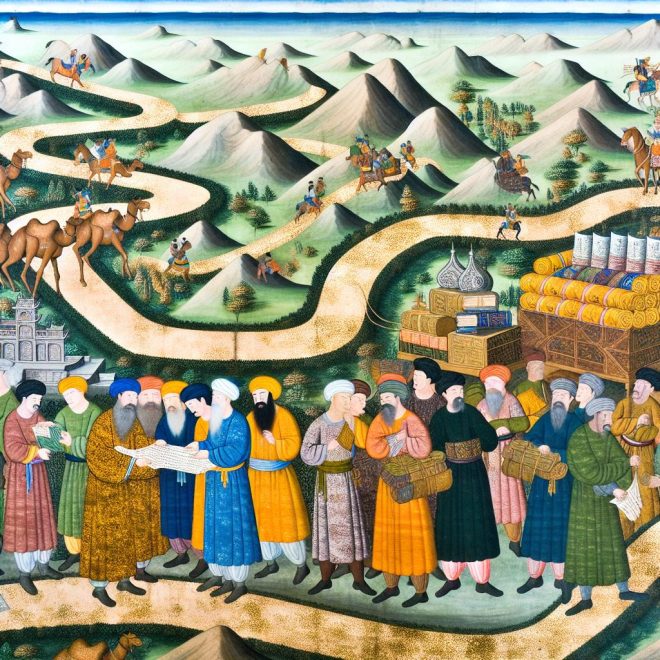Introduction to Ancient Trade Agreements
The Silk Road, a historically significant network of trade routes, facilitated cultural, commercial, and technological exchange between the East and West. While much focus is often placed on the vibrant goods exchanged, such as silk, spices, and precious metals, the agreements and treaties that underpinned these exchanges played a pivotal role in shaping its economy.
The Role of Trade Agreements in the Silk Road Economy
Ancient trade agreements were not merely transactional; they represented commitments and understandings between various nations and empires with diverse cultures and interests. These agreements served as frameworks for peace and cooperation, enabling merchants to travel safer and ensuring stable economic interactions.
Establishing and Maintaining Alliances
Among the essential aspects of these agreements was the establishment and maintenance of alliances. For instance, the Han Dynasty sought allies against common threats like the Xiongnu nomads. Such alliances were often formalized through treaties that included provisions for trade rights. Alongside military alliances, these agreements fostered economic partnerships and facilitated access to previously inaccessible markets.
These alliances were strategic for economic expansion. Establishing firm ties with neighboring territories reduced the risks merchants faced when traversing the vast expanse of the Silk Road. Moreover, alliances ensured a circulation of local currencies and knowledge exchange, fostering economic interdependence that was vital for the prosperity of empires.
Regulation and Taxes
Trade agreements and treaties often included terms regarding the regulation of goods and the imposition of tariffs. By setting agreed-upon tariffs, parties reduced the chance of disputes and maintained economic stability. This form of regulation ensured predictability in trade, allowed for the accumulation of public revenue, and mitigated the risk of fraud and smuggling.
Through these regulations, rulers and governments could also standardize trade practices, ensuring that participants adhered to agreed norms. Such structure was essential in preventing economic dominance by any single entity and enabled smaller regions to play significant roles in the trade network. Taxes and fees collected under these agreements helped maintain infrastructure that facilitated continuous commerce, including roads and trade hubs.
Innovation in Trade Policies
The trade agreements along the Silk Road were characterized by their innovative approaches to diplomacy and economics. In some instances, treaties included stipulations that went beyond conventional trade issues. They often addressed intellectual exchange, cultural promotion, and even the standardization of weights and measures, which were crucial for trade efficiency and fairness.
By encouraging the exchange of knowledge and technology, these policies aided in the diffusion of innovations like paper and gunpowder. The spread of these innovations eventually revolutionized societies far beyond the immediate scope of the Silk Road. Furthermore, the balance and equality provided by the standardization of weights and measures were paramount in ensuring parties felt fairly treated, sustaining trust in trade relationships.
Examples of Influential Treaties
While numerous agreements took place over the centuries, a few stand out in their impact on the Silk Road economy. The Peace Treaty between the Eastern Roman Empire and Persia in 562 AD exemplifies how geopolitical coalitions fostered safe trade environments. Likewise, the agreements under the Mongol Empire in the 13th century highlighted how centralized control could vastly expand trade routes and increase protection for traders.
These treaties functioned as pillars supporting a vast and complex network of exchanges, facilitating the movement of not only goods but also ideas and cultural values. The strategic locations fortified by these treaties enabled regional authorities to implement protective measures such as stationed guards at trade points, mitigating risks like theft and conflicts along crucial sections of the trade routes.
Long-term Impacts of The Treaties
These treaties not only affected contemporary traders but also laid the groundwork for future diplomatic and economic relations. As these agreements were often comprehensive, their principles influenced subsequent trade policies and negotiation strategies throughout Eurasia. They were instrumental in creating an interconnected world long before the advent of modern globalization.
The strategies employed in these treaties provided templates for managing intercultural and economic interactions. They underscored the importance of global thinking — recognizing that stable economies and peaceful relations often stem from respect and understanding across borders. Consequently, these treaties established a legacy that informed future trade practices and policy-making long beyond their immediate effects.
Conclusion
In conclusion, while the commodities exchanged along the Silk Road are often celebrated, understanding the trade agreements and treaties that shaped its economy is equally important. These agreements provided a backbone for international trade, fostering periods of economic prosperity and cultural exchange. Ancient trade agreements remind us of the power of diplomacy in bridging differences and promoting mutually beneficial relationships across vast distances.
By recognizing these ancient practices, we gain insights into how past societies navigated economic challenges and opportunities, and their relevance to global trade dynamics today. This understanding enhances our appreciation of how interlaced historical events shaped our contemporary world, highlighting the enduring influence of diplomatic efforts in international commerce.
